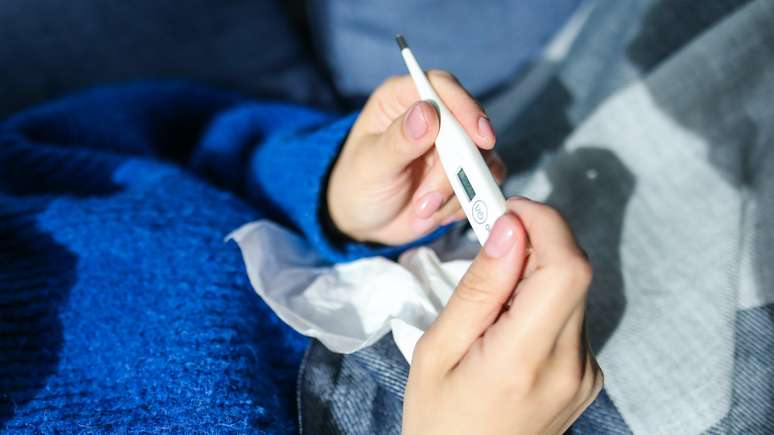In this week’s article, homeopathic pharmacist Jamar Tejada provides us with all the information about fever, how to measure it and how to properly deal with the symptoms.
When it comes to fever, despair strikes and the thought comes: “I’m sick.” The first thing everyone does is run after an antipyretic. Mothers, on the other hand, give their children cold baths in an attempt to lower the temperature. But is everything right? Is fever really a big deal?
html[data-range=”xlarge”] figure image img.img-d9ebe5b8795b6de7db7f1077b98ef6ceuc42zjq6 { width: 774px; height: 435px; }HTML[data-range=”large”] figure image img.img-d9ebe5b8795b6de7db7f1077b98ef6ceuc42zjq6 { width: 548px; height: 308px; }HTML[data-range=”small”] figure image img.img-d9ebe5b8795b6de7db7f1077b98ef6ceuc42zjq6, html[data-range=”medium”] figure image img.img-d9ebe5b8795b6de7db7f1077b98ef6ceuc42zjq6 { width: 564px; height: 317px; }HTML[data-range=”small”] .article__image-embed, html[data-range=”medium”] .article__image-embed {width: 564px; margin: auto 0 30px; }
First of all it is important to know that our body temperature is controlled by an area of the brain called the hypothalamus. This zone acts as a thermostat set to keep the internal organs at 37°C. Everything is very controlled. There is a balance between the peripheral organs (skin, blood vessels, sweat glands, etc.), which lose heat in contact with the environment.
When there is an imbalance in this balance, the production of heat by the internal tissue metabolic process causes a change in temperature. This is how fever appears, that is, when this natural thermostat raises the temperature by two or three degrees above the usual values or when our body is attacked by an external agent or by a disease of the internal organs.
We already understand that fever is not a disease, nor an evil, but a reaction of our body when something is wrong. Its cause is linked to various factors, such as viruses, bacteria, fungi, parasites, sun strokes, dehydration, adverse reactions to some drugs, central nervous system diseases, neoplastic diseases (liver, kidney, intestinal cancer, lymphomas, leukemia ), cardiovascular disease (heart attack, thrombophlebitis, pulmonary embolism), hyperthyroidism, some types of hepatitis, rheumatic diseases, among others.
The body temperature considered ideal varies between 36 °C and 36.7 °C, generally being lowest in the morning and highest in the late afternoon or evening. Changes up to one degree are acceptable under normal conditions. In women, for example, after ovulation, during the menstrual cycle and in the first trimester of pregnancy, there is a natural increase in temperature. Therefore, it is considered fever only when the temperature is above 37.8℃.
fever classification
- Fever: 37.3℃ to 37.8℃;
- Fever: above 37.8℃;
- High fever: generally considered to be from 39℃.
Fever check and thermometer
The only way to be sure that a person has a fever is to take their temperature with a thermometer, preferably an electronic one. Place the bulb of the thermometer in the folds of the armpit, wait about 5 minutes with the arm motionless and remove it only to take the reading.
Temperature can also be taken inside the mouth or rectum, the final portion of the large intestine, i.e. the anus. These methods should generally only be used in clinics or hospitals, as these areas often have a higher temperature than the temperature measured under the armpits.
Although “tapping the temperature” by touching the forehead is a very common method, it is not at all accurate and can be misleading. Using a thermometer is essential to accurately measure fever.
Measure the temperature several times and write down the values
Most febrile conditions are caused by common, short-lived infectious diseases, but since fever can also be one of the symptoms of several diseases, establishing the differential diagnosis is essential to guide treatment approaches.
It is also very important to measure the temperature three or four times a day and write down the values and times of the check. Knowing whether fever spikes are high or low and when they occur helps to identify the diseases that may be involved and to establish the diagnosis.
symptoms of fever
A fever occurs when the thermostat (hypothalamus) adjusts to cause the body to reach a higher temperature. At that moment, the chills begin, which can turn into shivering, followed by a feeling of intense heat and sweating. Other symptoms are muscle pain, joint pain, headache, weakness, listlessness, irritability, indisposition, loss of appetite, dry mouth and dehydration.
Especially in children, when the fever approaches 40°C or exceeds this limit, it can cause mental confusion, delusions and even convulsions.
fever treatment
Since fever is only a symptom, the choice of treatment is directly associated with the underlying disease, which is why it is necessary to treat the cause. For example, bacterial infections may require the prescription of antibiotics, a type of medicine that is absolutely ineffective when the agent of the infection is a virus. Antipyretic or antipyretic drugs should be used with caution — or when absolutely necessary — as treating a fever can end up masking the underlying disease.
Fever is generally generated by germs that cause short-term infections (flu, colds, some intestinal infections, tonsillitis, pneumonia, etc.), which the body’s own defense system manages to eliminate, so drugs are not needed. for fever. But, in general, hydration, rest and analgesics to relieve symptoms are sufficient measures for the patient’s well-being.
On the other hand, fever causes drowsiness, indisposition and lack of appetite and can also make medical evaluation difficult. Therefore, the use of antipyretics can also be used to improve comfort and well-being.
Fever and seizures in children
Convulsions caused by fever occur only in children who already have a genetic predisposition and can also occur with subfebrile conditions, as low as 37°C. Fortunately, febrile seizures don’t cause major discomfort or neurological damage, but parents are expected to have already sought medical help before they get to that point.
Should you take off your clothes to bring down a fever?
Even if the surface of the body is warm, the person with fever tends to feel very cold. It is therefore better to stay warm, but without exaggerating to prevent the body temperature from rising further. However, after taking an antipyretic, the fever will decrease and the child may sweat excessively, feeling very hot. In this case it is better to stick to light clothes to feel more comfortable.
Why do we feel cold when we have a fever?
With a fever, our body begins to lose heat rapidly. This process begins when the blood vessels in the skin begin to dilate to send heat outside the body, hence the feeling of cold.
Does rubbing alcohol on the body and taking a cold shower help lower a fever?
No. Alcohol evaporates easily from the surface of the body, causing a cooling sensation on the skin, just like a cold shower. Furthermore, the body can understand that the person has suffered a very sudden drop in temperature, try to compensate for it and increase the fever even more. Don’t forget that alcohol can poison children.
Don’t forget that increased body temperature accelerates dehydration, as it can cause excessive sweating. Therefore it is very important to keep the patient always hydrated with water, herbal teas and natural juices.
Can we anticipate the interval indicated in the leaflet if the fever rises quickly?
No. You are turning a safe medicine into a potentially dangerous drug. Remember that very large doses of acetaminophen, for example, can damage your kidneys and liver. Get help from your doctor if your fever doesn’t go down. In general, it is recommended to repeat the dose of antipyretic 4-6 hours after the previous drug intake. Some medications, such as dipyrone, require longer intervals and may be repeated every eight hours unless otherwise advised by your doctor.
How does homeopathy treat fever?
When prescribing homeopathy during feverish processes, the homeopathic doctor does not aim to lower the fever, but rather to help the body complete this defense work more promptly and to circumvent the possible side effects that accompany it. For example, if the fever is due to an infection, the aim of the homeopathic treatment will be to cure this infection and not the “fever” symptom which, of course, will reduce as the causal agent is eliminated, bringing the individual to his biological equilibrium.
Source: Terra
Ben Stock is a lifestyle journalist and author at Gossipify. He writes about topics such as health, wellness, travel, food and home decor. He provides practical advice and inspiration to improve well-being, keeps readers up to date with latest lifestyle news and trends, known for his engaging writing style, in-depth analysis and unique perspectives.




![Pre -Si Grand Soleil: Summary of Episode on Tuesday, October 14, October 14, 2025 [SPOILERS] Pre -Si Grand Soleil: Summary of Episode on Tuesday, October 14, October 14, 2025 [SPOILERS]](https://fr.web.img6.acsta.net/img/90/06/9006f8922e8bfda0a3290f9a6ff3fa74.jpg)


